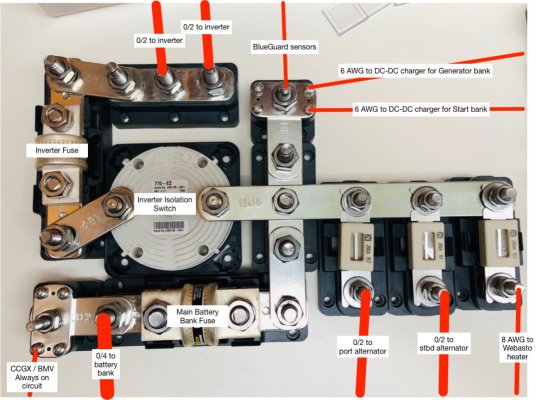stevemitchell
Guru
- Joined
- Sep 25, 2018
- Messages
- 542
- Location
- USA
- Vessel Name
- Aruna
- Vessel Make
- Kristen Yachts 50 Pilot House
I've been finishing up the plans for an upgraded battery bank, new inverter, alternators, distribution, fuses, and a ton of other things to bring my house bank up to the standards I want. One thing I used on my previous boat was the Marinco Pro Installer series of busses and switches. I didn't have enough space or a big enough system to warrant too many of the various pieces.
With Rendezvous, I have a much bigger system and with the upgrade, and have decided to use more of the bits and pieces from their product line.
I needed:
Doing this traditionally would have required lots of wires, crimps, and space.

Above is my current iteration, which I believe is pretty close to final. One of the things I love about this system is that you can lay it out on the table and play around with it, just like big power legos. It's pretty fun, and I can admit that I may have spent more time than necessary fooling with things.
All of the various components are the same height, and use Link Bars to connect them together instead of individual wires. Those bars come in a bunch of different lengths and sizes, and can either link two products together, or the larger ones, like the 5 hole one above in the middle right, link a lot more. There are current limits depending on which one you choose, so it is important to read the specs for them.

I've used the battery switch on at least 10 other installs, even without the rest of the system as it allows you to mount the meaty part of it to the wall, connect the conductors, and put the cover on, rather than struggling with connecting things to the back of a switch, spinning it around, etc.
Overall, I am very happy with how compact and secure this whole thing is. In particular, I like how few cables there are, and I am excited to get the rest of the project underway tomorrow.
With Rendezvous, I have a much bigger system and with the upgrade, and have decided to use more of the bits and pieces from their product line.
I needed:
- Main battery bank fuse
- Always on power for Victron CCGX / BMV prior to any switch/fuse
- 2x ANL fuses for new alternators
- 1x ANL fuse for Webasto heater
- Small loads off of in-line fuses or small panel (temp/fire/battery sensors)
- Inverter fuse
- Inverter isolation switch
- Bus for dual inverter cables
Doing this traditionally would have required lots of wires, crimps, and space.

Above is my current iteration, which I believe is pretty close to final. One of the things I love about this system is that you can lay it out on the table and play around with it, just like big power legos. It's pretty fun, and I can admit that I may have spent more time than necessary fooling with things.
All of the various components are the same height, and use Link Bars to connect them together instead of individual wires. Those bars come in a bunch of different lengths and sizes, and can either link two products together, or the larger ones, like the 5 hole one above in the middle right, link a lot more. There are current limits depending on which one you choose, so it is important to read the specs for them.

I've used the battery switch on at least 10 other installs, even without the rest of the system as it allows you to mount the meaty part of it to the wall, connect the conductors, and put the cover on, rather than struggling with connecting things to the back of a switch, spinning it around, etc.
Overall, I am very happy with how compact and secure this whole thing is. In particular, I like how few cables there are, and I am excited to get the rest of the project underway tomorrow.


